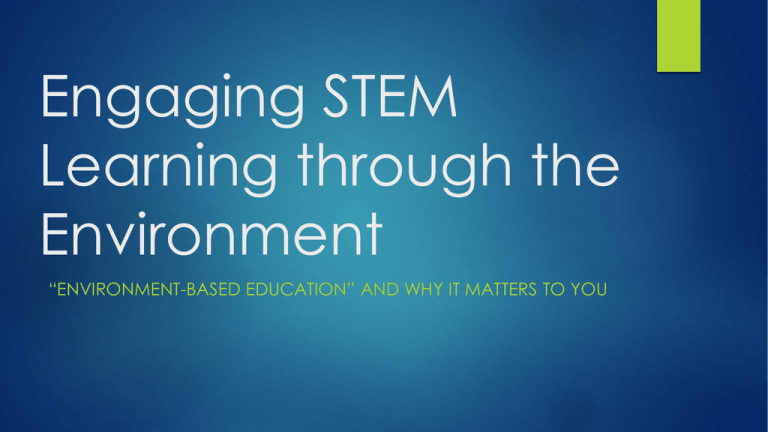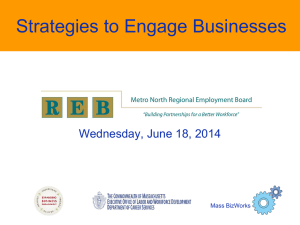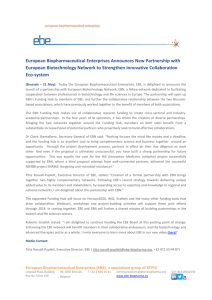Engaging STEM Learning through the Environment
advertisement

Engaging STEM Learning through the Environment “ENVIRONMENT-BASED EDUCATION” AND WHY IT MATTERS TO YOU Introductions Bryan Ehlers Director, Office of Education and the Environment California Department of Resources Recycling and Recovery (CalRecycle) Gerald Lieberman, PhD. State Education and Environment Roundtable Will Parish Founder and President Ten Strands Session Overview Key Questions What is environment-based education (EBE)? What are California’s Environmental Principles and Concepts (EP&Cs) and why are they significant for the future of STEM? What opportunities and challenges do you see for using the environment to connect students to STEM learning? “The Environment” Broadly defined The natural systems in which all human activity is embedded The air we breathe, the water we drink, the food we eat The context for our daily lives NOT only pristine mountain meadows The Environment and STEM What does the environment have to offer? Intrinsically context engaging Meets students “where they’re at” in terms of their daily lives Relevant, real-world issues of importance Environment-Based Education (EBE) What is it? A framework for instruction Focuses on standards-based educational results Uses the environment and related issues as a context for learning *Based on Education and the Environment: Creating Standards-Based Programs for Schools and District, (Lieberman, 2013) Environment-Based Education (EBE) What is it not? Not the same as “environmental education” which focuses primarily on environmental literacy and environmental issues – instead, EBE’s focus is traditional academic content standards Not environmental advocacy – EBE encourages students to think critically about the world around them and arrive at their own conclusions based on sound science and reasoning Environment-Based Education (EBE) Why use this approach? Research-based model Environment-Based Education (EBE) Why use this approach? (continued) Higher scores on standardized measures of academic achievement Increased student engagement and enthusiasm for learning Reduced discipline and classroom management problems Greater student pride and ownership in accomplishments Environmental literacy will be essential to our prosperity in the 21st century and beyond! Environment-Based Education (EBE) What can we accomplish with EBE? Three core goals: 1. Help students achieve success with academic content standards 2. Develop their understanding of interactions between natural and human social systems 3. Prepare students to be active members of a civil society with the skills they need to identify and resolve environmental challenges Environment-Based Education (EBE) How did the EBE shift begin? The ball began rolling with 2003 California legislation: Established core environmental big ideas for all K-12 students California Environmental Principles and Concepts – EP&Cs Required creation of a “model curriculum” California Education and the Environment Initiative (EEI) Curriculum (State Board of Education approved, 2010) Requires future state-adopted curriculum to incorporate the EP&Cs i.e., follow the EEI model CA Environmental Principles & Concepts What are the EP&Cs? Principle I – People Depend on Natural Systems The continuation and health of individual human lives and of human communities and societies depend on the health of the natural systems that provide essential goods and ecosystem services. PRINCIPLE I People Depend On Natural Systems CA Environmental Principles & Concepts What are the EP&Cs? PRINCIPLE I Principle II – People Influence Natural Systems The long-term functioning and health of terrestrial, freshwater, coastal and marine ecosystems are influenced by their relationships with human societies. People Depend On Natural Systems PRINCIPLE II People Influence Natural Systems CA Environmental Principles & Concepts What are the EP&Cs? Principle III – Natural Systems Change in Ways that People Benefit from and Can Influence Natural systems proceed through cycles that humans depend upon, benefit from and can alter. PRINCIPLE I People Depend On Natural Systems PRINCIPLE II People Influence Natural Systems PRINCIPLE III Natural Systems Change in Ways that People Benefit From and Can Influence CA Environmental Principles & Concepts What are the EP&Cs? Principle IV – There are no Permanent or Impermeable Boundaries that Prevent Matter from Flowing Between Systems The exchange of matter between natural systems and human societies affects the long-term functioning of both. PRINCIPLE I People Depend On Natural Systems PRINCIPLE II People Influence Natural Systems PRINCIPLE IV There are no Permanent or Impermeable Boundaries that Prevent Matter from Flowing Between Systems PRINCIPLE III Natural Systems Change in Ways that People Benefit From and Can Influence CA Environmental Principles & Concepts What are the EP&Cs? Principle V – Decisions Affecting Resources and Natural Systems are Complex and Involve Many Factors Decisions affecting resources and natural systems are based on a wide range of considerations and decisionsmaking processes. PRINCIPLE I People Depend On Natural Systems PRINCIPLE II People Influence Natural Systems PRINCIPLE IV There are no Permanent or Impermeable Boundaries that Prevent Matter from Flowing Between Systems PRINCIPLE III Natural Systems Change in Ways that People Benefit From and Can Influence PRINCIPLE V Decisions Affecting Resources and Natural Systems are Complex and Involve Many Factors CA Environmental Principles & Concepts What’s next? EEI Curriculum uses EP&Cs Some organizations aware and aligning materials and programming New K-12 science curriculum framework will integrate EP&Cs with Next Generation Science Standards By 2018-19 new science textbooks will contain EP&Cs Implications for NGSS Instruction What will NGSS + EP&Cs look like? [Placeholder for example of Jerry’s framework material. Add additional slides as necessary.] EBE and STEM Opportunities and Challenges Discussion Prompts – From the standpoint of your organization or sector: What does EBE have to offer STEM? What are the best opportunities to use EBE to expand and/or improve STEM learning for Californians? What are the biggest challenges to capitalizing on opportunities to leverage EBE in support of STEM? How might these challenges be confronted and/or overcome? What do you see as next steps for helping bring EBE to your community of STEM stakeholders, and what support might you need to achieve success? EBE and STEM Opportunities and Challenges What does EBE have to offer STEM? What are the best opportunities to use EBE to expand and/or improve STEM learning for Californians? EBE and STEM Opportunities and Challenges What are the biggest challenges to capitalizing on opportunities to leverage EBE in support of STEM? EBE and STEM Opportunities and Challenges How might these challenges be confronted and/or overcome? EBE and STEM Opportunities and Challenges What do you see as next steps for helping bring EBE to your community of STEM stakeholders, and what support might you need to achieve success? EBE and STEM Discuss findings Questions? EBE and STEM Wrap-up and Takeaways EBE is a state policy initiative with growing relevancy for STEM (e.g., EP&Cs in new science textbooks by 2018-19) Many opportunities to capitalize on environment as engaging context for STEM learning No time like the present to begin identifying and planning to confront and overcome challenges Thank you! And please feel free to contact us Bryan Ehlers Director, Office of Education and the Environment California Department of Resources Recycling and Recovery (CalRecycle) www.californiaeei.org Gerald Lieberman, PhD. State Education and Environment Roundtable www.seer.org Will Parish Founder and President Ten Strands www.tenstrands.org




